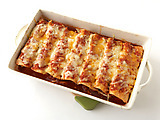Meet aquafaba: the humble bean juice taking the baking world by storm...
Geege Schuman stashed this in Legumes
Stashed in: Good Eats!, Desserts!, Recipes!, Things that should get eaten, Food Hacks, Recipes, Beans!
As it turns out, this seemingly unappetizing bean brine creates the most airy and decadent concoctions. The liquid is called Aquafaba and it is the secret sauce for achieving the perfect peaks of meringues, the ethereal crunch of macarons, and the utter divinity of a Belgian waffle. Better yet, it comes from something that would otherwise go down the drain.
Chickpeas are an excellent and cheap source of protein, which makes aquafaba arguably the perfect egg substitute. According to Aquafaba.com (the official aquafaba website) the verdict is still out on the liquid’s nutritional makeup and what exactly makes it such an effective egg replacer. Experiments reveal that aquafaba is an emulsifier, a leavening agent, and a foaming agent. Just by looking at it, one can ascertain the consistency is more in line with egg whites, while lacking the sticky, drippy consistency of yolks — hence its ability to produce such delicate meringues and other desserts as light as air.
Is it just for people allergic to eggs, or does it actually make better meringues, macarons, and waffles?
You asked. From Aquafaba crowdsourcing site:
There have been a few opinions revealed in the development group(s) about the science of aquafaba and why it works the way it does. From our crowd-sourced experimentation, we know it's an emulsifier, a leavening agent, and a foaming agent. It provides liquid content and agreeable organoleptic properties when baked, unlike traditional commercial egg replacers. That's a good start.
We also know that it is not a complete egg replacer. It has some of the properties of albumen and some of the properties of the yolk, but not all of both, which gives it a unique profile, as far as egg replacers go.
Until a formal chemical and nutritional analysis is released publicly, the community is left to hypothesize about mechanisms of action and composition. Ideas that have been discussed so far:
- lipids / fatty acids
- fibers / mucilage (similar to flax)
- proteins (presumably albumins, possibly globulins. Legumin and vicilin may be suspects.)
- glycosides (possibly saponins)
- sugars / carbohydrates / starches
So, your mileage may vary and it's not a complete egg replacer but it's good for experimenting.













10:05 AM Jan 06 2016